Pasta Primavera is packed with lots of different vegetables and a light creamy sauce that coats the pasta. It's so easy to make, so colorful and delicious.
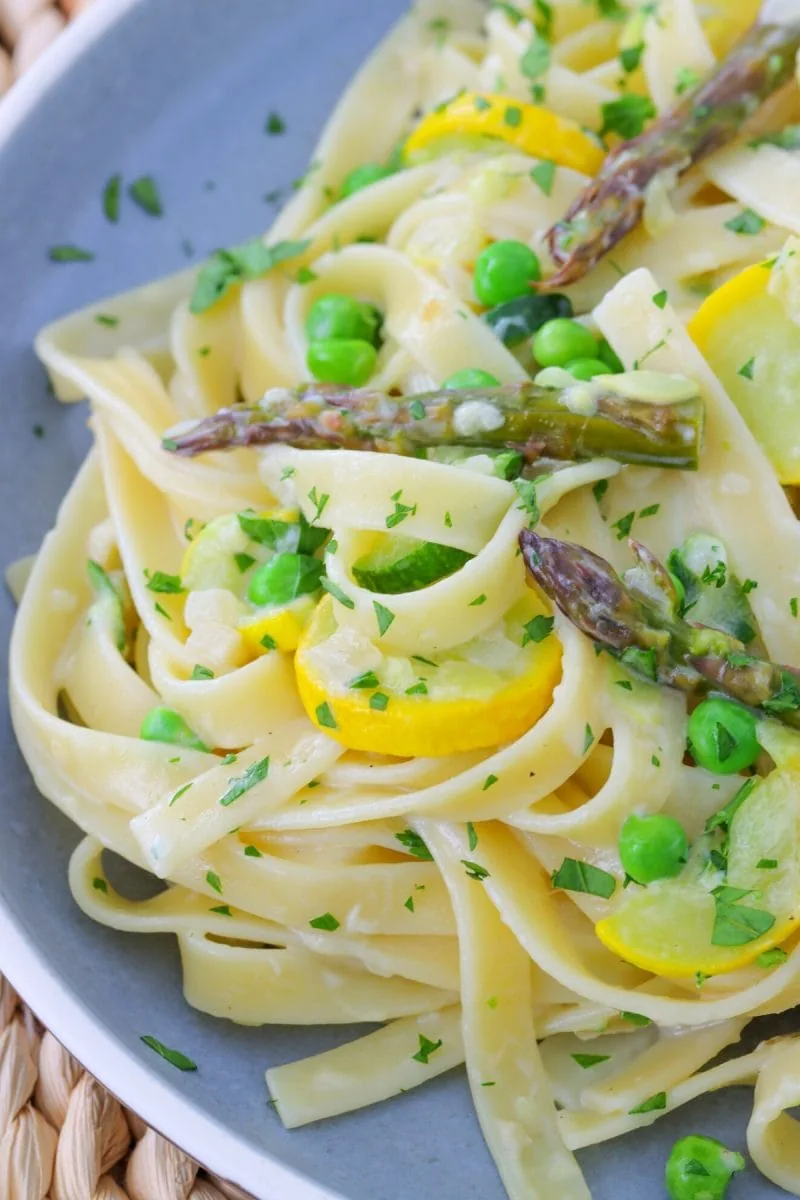
I love the simplicity of Pasta Primavera but it certainly isn't boring. When farmer's markets and supermarket shelves are stocked with glorious vegetables,this is the perfect recipe to make. With a variety of vegetables - zucchini, yellow squash, asparagus and peas, it's so pretty and vibrant.
While the pasta water is coming to a boil and the pasta cooks, the vegetables roast in the oven. Roasting vegetables is my favorite! It's so easy, hands off, the vegetables retain their shape pretty well. Best of all, their naturals sugars are drawn out as caramelize a bit and get golden making them extra delicious.
I also make a simple sauce with sauteed onions, garlic, cream and parmesan. It's lightly coats the pasta and veggies without making everything heavy and clumped together. This would be amazing with homemade pasta, but it works just as well with store bought pasta too.
What is Pasta Primavera?
Pasta Primavera is a classic recipe that is featured in many restaurant menus. It's a favorite for a reason - it's so fresh and colorful, with lots of vegetables and a light cream sauce.
Ingredients:
- pasta
- Our favorite pasta for this recipe is fettuccine or fresh homemade pasta (such a treat!), but just about any pasta will work for this recipe - spaghetti, penne, fusilli, casarecce, farfalle and many more.
- vegetables
- asparagus
- zucchini
- yellow squash
- peas (unless you grow peas in your garden, it's hard to find fresh garden peas, so I use frozen peas 99% of the time.)
- olive oil
- onion + garlic, for the sauce
- heavy cream, for the sauce
- Parmesan cheese
- lemon juice, optional
- fresh parsley
- salt, ground black pepper
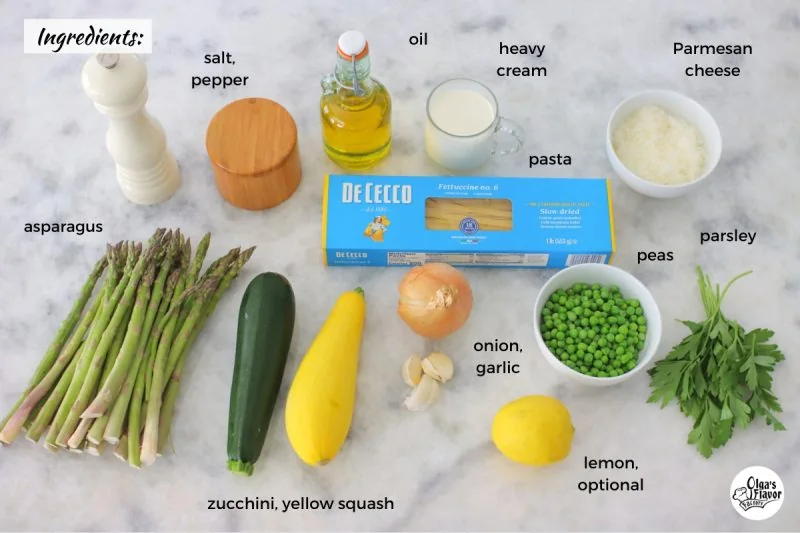
The fun thing about this recipe is it's so versatile. Switch up the vegetables depending on what's in season, what you have in the refrigerator, and, of course, your taste preferences.
Here are some great options:
- broccoli
- cauliflower
- bell peppers
- tomatoes
- spinach
- mushrooms
- snap peas
- red onion
- brussels sprouts
- carrots (carrots need more time to cook and get softer than most of the other veggies on this list)
Pasta Primavera Recipe
- Preheat the oven to 425 degrees. Place a large rimmed baking sheet inside the oven while the oven is preheating and let it get rip-roaring hot.
- This is a trick I use a lot for roasting veggies. They will immediately start to sizzle and sear, instead of heat up slowly, steam and only then, after the vegetables are already cooked most of the way, start to sear. What do you get? Mushy, ugly gray/tan vegetables.
- Bring a large pot of salted water to a boil for the pasta. When the water boils, add the pasta and cook until it's the way that you like it. (Before draining the pasta, save about 1 cup of the pasta water.)
- Meanwhile, prep the asparagus by taking one of the spears and holding it towards the bottom of the spear, bend it until it naturally snaps. The part that snaps off is really tough and fibrous and you definitely don't want to be chewing on it.
- You can line up all the asparagus spears and cut off the bottom of the asparagus at the point where the first spear broke off. You can also continue snapping each spear; it will only take you a minute to do. Throw out the fibrous spear tips. (Unless you want to save them to be used in broth later.)
- Mix the asparagus with 1 Tablespoon of olive oil. Season with salt and pepper.
- Prep the zucchini and yellow squash. Cut, then mix with another tablespoon of olive oil and season with salt and pepper. Mix to combine.
- Place the asparagus, the zucchini and yellow squash on the preheated baking sheet.
- The baking sheet will be searingly hot, so be careful! Roast the vegetables in the preheated oven for about 10 minutes, until the vegetables are tender.
- When roasting the asparagus, I like to keep it whole so it is more plump and juicy while in the oven, then, right before adding it to the pasta, I cut it into smaller pieces.
- While the veggies are roasting and the pasta is cooking, make the sauce.
- Saute the onion and garlic until tender and just starting to turn golden.
- Pour in the heavy cream, bring to a boil, reduce the heat to a simmer and cook for about 2 minutes, until the sauce thickens.
- Add the Parmesan cheese, whisk to combine. Set aside and keep warm.
- Gently toss the pasta, roasted veggies, sauce, frozen peas and parsley together. (There's no need to thaw the peas first. The heat of the pasta will zap the cold right out of them.) You can also add some fresh lemon juice to add a bit of acidity and bright flavor to the dish.
- Add some of the reserved pasta water, to loosen the sauce a bit, adding as much as you think it needs. Garnish each serving with extra parsley and Parmesan cheese.
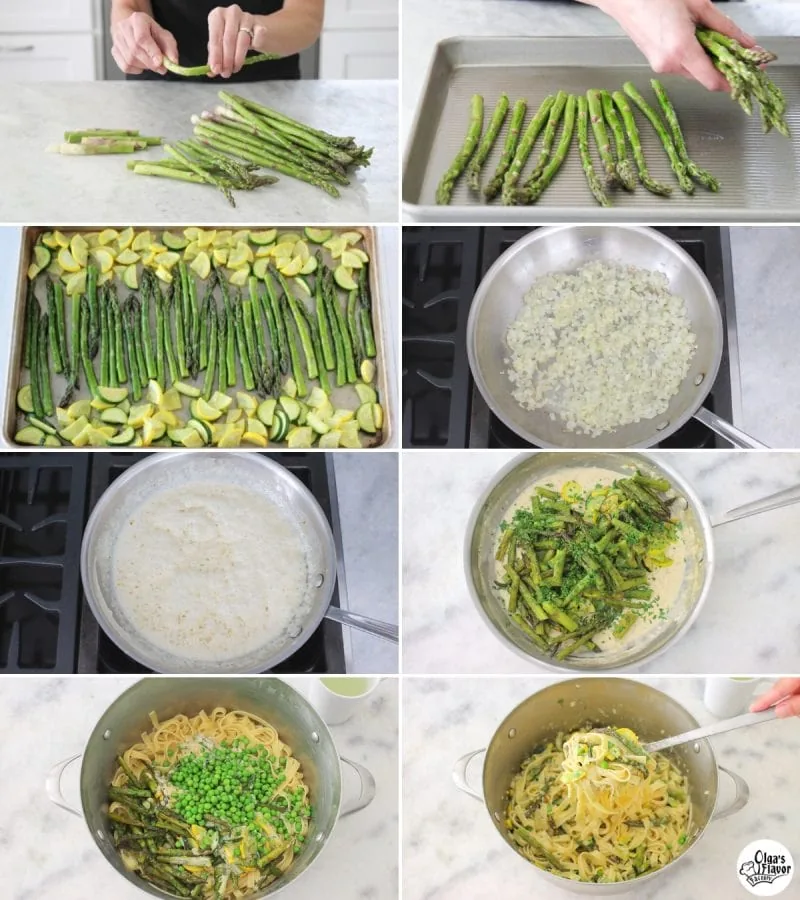
Using Fresh Pasta?
When the vegetables and the sauce are both ready, add the fresh pasta to the boiling water and cook for 3-5 minutes only. Fresh pasta cooks SO quickly, which is why I have the rest of the ingredients ready to go before I cook the pasta.
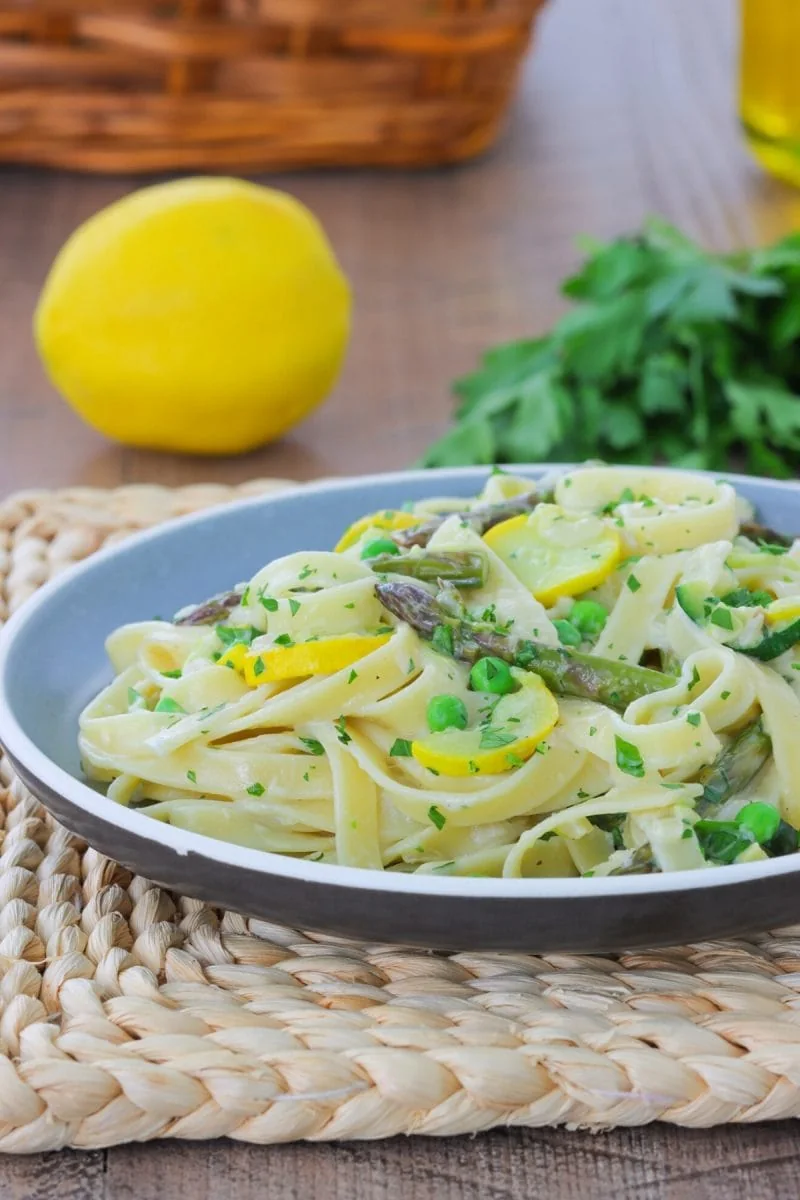
Pasta Primavera
Pasta Primavera is packed with lots of different vegetables and a light creamy sauce that coats the pasta. It's so easy to make, so colorful and delicious.
- Prep Time: 15 mins
- Cook Time: 20 mins
- Total Time: 30 mins
- Yield: 6
- Category: Entree
Ingredients
- 12 oz. pasta (fettuccine, spaghetti, penne,
- 1 lb asparagus
- 1 medium zucchini, halved and sliced
- 1 medium yellow squash, halved and sliced
- 3 Tablespoons olive oil
- 1 onion, chopped
- 3-6 garlic cloves, minced
- ½ cup heavy cream
- ⅓ - ½ cup Parmesan cheese, finely grated
- ½- 1 cup frozen peas
- 1-3 Tablespoons freshly squeezed lemon juice, optional
- 1-2 Tablespoons fresh parsley, minced
- salt, ground black pepper
Instructions
- Preheat the oven to 425 degrees Fahrenheit. Place a large rimmed baking sheet inside the oven while the oven is preheating.
- Bring a large pot of salted water to a boil. Cook the pasta the way you like it. Save about 1 cup of the pasta water before draining.
- Meanwhile, prep the asparagus by cutting off the bottom fibrous part. Toss the asparagus with 1 Tablespoon of olive oil and some of the minced garlic. Season with salt and pepper and mix it all together to combine.
- Mix the zucchini and yellow squash with another Tablespoon of olive oil, salt and pepper to taste and a bit more of the minced garlic. Place the asparagus, the zucchini and yellow squash on the preheated baking sheet. The baking sheet will be searingly hot, so be careful!
- Roast the vegetables in the preheated oven for about 10 minutes, until the vegetables are tender.
- Meanwhile, heat the remaining 1 Tablespoon of oil in a skillet. Add the onion and all the remaining garlic. Season with salt and pepper. Cook for about 5 minutes, until tender and lightly golden.
- Pour in the heavy cream, bring to a boil, reduce the heat to a simmer and cook for about 2 minutes, until the sauce thickens.
- Add the Parmesan cheese, whisk to combine. Set aside and keep warm.
- When the vegetables are roasted and the pasta is ready, gently toss the pasta, roasted veggies, frozen peas, cream sauce, and parsley together.
- You can add some fresh lemon juice to add a bit of acidity and bright flavor to the dish, but that is optional.
- Add some of the reserved pasta water, to loosen the sauce a bit, adding as much as you think it needs.
- Garnish each serving with extra parsley and Parmesan cheese.
Notes
The thing about Pasta Primavera is that you can use many kinds of vegetables in this dish. Think bell peppers, tomatoes, mushrooms, snap peas, spinach, broccoli, broccolini or carrots. I'm sure you get the idea.You can add some sautéed, roasted or grilled chicken to this dish too.
If You're Using Fresh Pasta:
When the vegetables and the sauce are both ready, add the fresh pasta to the boiling water and cook for 3-5 minutes only. Fresh pasta cooks SO quickly, which is why I have the rest of the ingredients ready to go before I cook the pasta.
Asparagus:
When roasting the asparagus, I like to keep it whole so it is more plump and juicy while in the oven, then, right before adding it to the pasta, I cut it into smaller pieces.
This is an updated recipe of the Pasta Primavera recipe that I originally published on April 30, 2014. I added a video, clarified the instructions and added new photos, but the recipe is still the same.
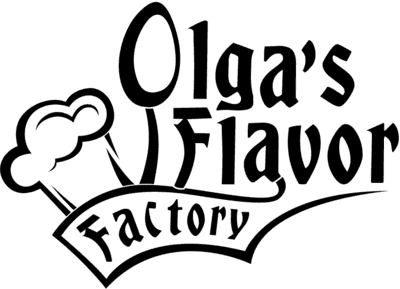
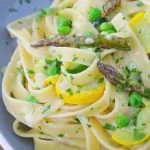
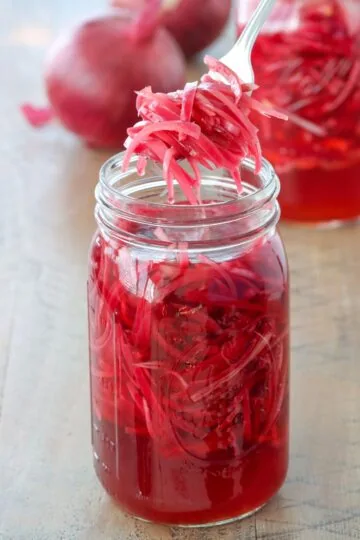
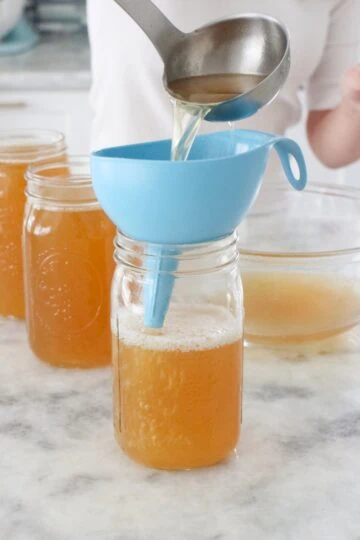
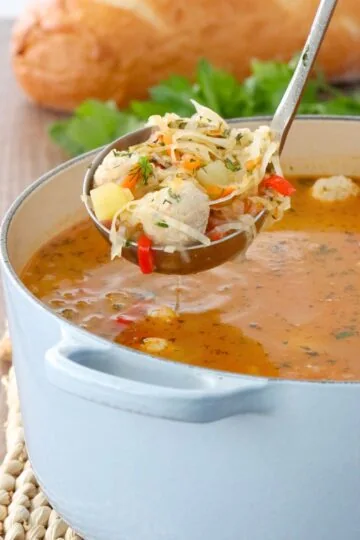
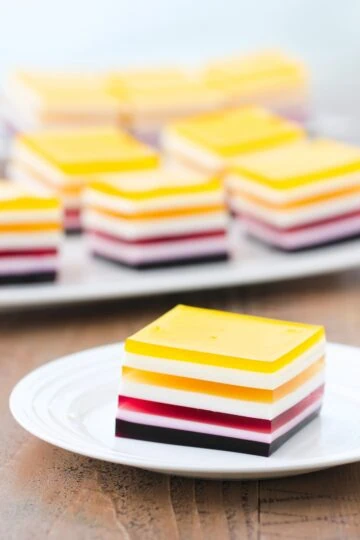
Exquisite!! Followed the recipe exactly and glad I did because it’s perfect the way she created it.
I made this dish.. it is sooo GOOD! I did not mix everything because I was afraid it would turn dry throughout the day. I also added some shredded chicken to the sauce. Thank You so much for sharing it!!
Thanks so much for taking the time to write, Erica:). This is one of my favorite pasta dishes. I'm glad you enjoyed it too.
Olga- I can wait to try this! I'm really curious about the pasta. is there a taste difference between fresh and dry? is it healthier? Why do you prefer the fresh? is it faster/easier to prepare?I know it is more expensive so just wondering 🙂
Absolutely, Olga. The flavor and texture of fresh pasta is completely different than dry boxed pasta. Fresh pasta is very tender and delicate and has a different taste too. I don't know if it's healthier or not. That would depend on the pasta. There are so many different varieties. You can certainly use regular dry pasta for this recipe, if you would prefer.
OH MY GOODNESS!!!
Another temptation!!!
I made this dish yesterday but tried just a small amount of PASTA PRIMAVERA. it was gone until I came back from evening church service. (even I make 16 oz of pasta)
However I was happy I roasted full sheet of veggie ( big zucchini, yellow squash, red, yellow and orange bell peppers, celery, carrots) and absolutely agree with Olga because THEY WERE SOOO GOOD.
I use just half of my roasted veggie in this recipe. Rest of them I keep in my refrigerator for another time. BUT!!! probably I will not have chance to make one more time because I ate almost all of them today ):
You know Olga, I tried this similar recipe last summer at my friend home and even copy her recipe but It take a lot of time because she fried all kind of veggie separately using four or more pans using olive oil and then mixed all ingredient together.
Your recipe it so easy to make, the same taste or even better, healthier( using less oil) and much less time.
THANKS AGAIN
FIVE STARS
THIS RECIPE WILL BE IN MY FAVORITE ALL SUMMER>
Thanks for such a enthusiastic feedback, Nina! I am thrilled that you enjoyed the Pasta Primavera. I love how simple it is to prepare and I always roast extra vegetables just because they are so delicious, I eat them right from the pan:).
I made this tonight and it was very good. I didn't have asparagus on hand, so I roasted carrots as a substitute. Yum!
This is the perfect dish to use whatever's on hand:).
Thanks so much for the tip about roasting vegetables! I'd never heard of it before. Such a lovely blog 🙂
Go you for being so thirty! 🙂 Also, what a great recipe! 🙂
Thanks, Lena:).
You're an alchemist Olga:)) transforming lead into gold so to speak:) fantastic post and amazing quality photos! Keep on keeping on!!
Alchemist, huh? I'll take it!
This looks yummy and so simple! Definitely good idea for using up all the left over ingredients
It really is:).